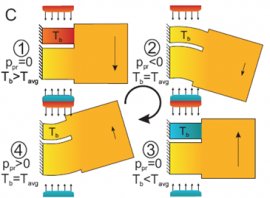
The vast majority of motors that power our planes, trains, and automobiles are heat engines. They rely on the rapid expansion of gas as it heats up to generate movement.

These engines play a crucial role in our infrastructure. But attempts to shrink them by any significant amount have mostly ended in failure. Today, the smallest heat engines have a volume of some 10 ^ 7.
That looks set to change with the announcement by Peter Steeneken and pals at NXP Semiconductors in the Netherlands that they have shrunk the heat engine by seven orders of magnitude. Yep, seven!
Their heat engine has a volume of just 0.5 cubic micrometers.
Here’s how it works. The new heat engine is essentially a bar of piezoelectric material whihc expands and contracts when an alternating current is applied. So far so good.
The expansion and contraction also changes the resistance of the bar and so also the amount of resistive heat that is generated. So passing a DC current through the bar at the same time as the AC current causes the bar to heat up and cool down. This heating and cooling also causes an expansion and contraction of the bar.
Crucially, there is a phase lag between the piezoelectric and thermal expansion and contractions.
So by choosing just the right driving frequency, it is possible to create a resonant effect in which the mechanical displacement of the bar is amplified.
This is the regime in which the bar acts like a heat engine, pushing and pulling to do work.
Steeneken and co have tested the idea in a preliminary design and shown it to work well. And they’ve also shown that reversing the thermodynamic cycle turns the the engine into a heat pump or refrigerator.
Of course, there are other, similarly sized refrigerators that work using the Peltier effect but this one has an important advantage. “In contrast to the Peltier effect, the direction of the thermal current does not depend on the direction of the electrical current, ” say Steeneken and company.
Refrigeration may turn out to be the most important near term application. The ability to pump heat away from microchips efficiently is nothing to be sniffed at.
It’s future as a motor is less clear. It’s relatively straightforward to make electrostatic motors that work on this scale and we’ve looked at plans to build electric motors on the quantum scale.
Then there is the tricky question of efficiency. Today’s macroscopic heat engines are clearly more efficient than biological ones. But Steneeken readily admits that “it remains to be seen whether they can ever compete with biological or artificial molecular motors on the microscale.”
YOU MIGHT ALSO LIKE












